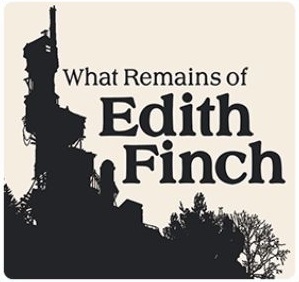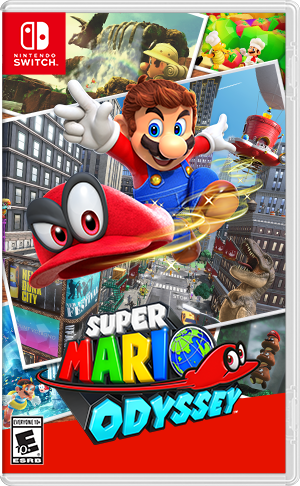What Remains of Edith Finch
The Switch continues to be a great place to catch up on older games. In 2017, What Remains of Edith Finch, released for PC, PS4, and XBox 360, piqued my interest after it won a smorgasboard of awards. I didn't have a PS4, an XBox360, or a PC that could run the game, so for me, the later-released Switch version gave What Remains of Edith Finch a new lease on life.

|
| The previous sentence is maybe not the best descriptor, given this game's subject matter |
In all honesty, as much the graphical beauty and dark mystery surrounding What Remains of Edith Finch piqued my interest, the game's "walking simulator" vibe turned me off...which is why I waited for a very good eShop sale before purchasing. The game does look great, though. The majority takes place in and around an old mansion on a Pacific Northwest island, and that mansion and its surroundings are beautifully realized. There's imaginative detail everywhere, beautiful work with lighting and shadows. If there's a flaw, it's the same as with most Switch ports of graphically intense games--the edges feel a little softened, and distances are a little blurred. This hasn't been a huge distraction in many of these ports, but here, as in Doom, etc., it is still noticeable.

|
| I don't think that treehouse is up to code |
What Remains of Edith Finch's sound design is outstanding. The voice acting is stellar, the music like something from an Oscar-nominated film. Weather effects, sound effects, put a pair of headphones on, and you are in this game.

|
| A little bummed, though, that you can't take all these pots and pans, put them on the floor, and play drums on them |
I also appreciate Edith Finch's sense of mystery. I like that the game very slowly reveals its cards, with a big one shown at the end that seems to have hit some players much harder than it did me. It seems that you, the player, might be the last in the unlucky Finch line, a family populated by some of the most unfortunate folks imaginable. You travel through the old house, once your childhood home, essentially going from room to room, often reliving the former occupants deaths.

|
| Do tell! |
So yes, that kind of means What Remains of Edith Finch is a walking simulator. By "walking simulator," I mean a game where you just walk around, and the game happens to you. It's essentially just like being in a movie where you have to hold down the play button. Thankfully, What Remains of Edith Finch requires the player to do a little bit more than that, but unfortunately, this still feels like more of an interactive film than a video game...at least to this old codger.

|
| By "old codger" I mean me, not Walter. |
Generally, going into a dead family member's room results in a tale surrounding their death, and essentially, an extremely easier mini-game, like making toy frogs jump around a bathtub as it overflows, or swiping left to right to chop fish, as one reflection revolves around that particular family member's menial job. I have to admit, the different variety of storytelling methods used in each flashback are diverse and clever. The hook here is that the mini-games do actually make each individual tale more poignant, which in turn makes the game's final message more moving, even if it isn't a message we haven't heard in a million other works of art. At least it's a worthwhile one.

|
| This fish ain't gonna chop themselves |
"Art" is the key word here. What Remains of Edith Finch has often been used to push the "video games can be art" narrative. While I do believe that What Remains of Edith Finch is surely art, I don't believe it's the best candidate for this argument, as it's hardly a game. You essentially just follow a trail of onscreen text around the house and experience what amounts to a visual novel. I feel something both evocative and highly interactive like The Legend of Zelda: Breath of the Wild is a far better candidate for the argument...and at the same time I think this argument is stupid.
 |
| Not stupid: this lamp. Look at this damn lamp. Look at it! |
As much as I admire some of the critics who pushed the "video games can never be art" perspective, the fact of the matter is, every new media form receives pushback from the old guard that "New media form I don't understand is not art!" However, crafting an immersive, involving gameplay experience is creating a work of art. The original Super Mario Bros. is a work of art. Hell, Tetris is a work of art; how many other things crafted by humanity have been as accurate a representation for the endless, unstoppable encroachment of time? I think it is silly to say that a game more resembling older forms of art, i.e. cinema, is the best candidate to argue that games are "worthy" of being called art. Eventually, everyone who dismisses video games as unartful trivialities will be dead, and the argument will die. Hell, eventually everyone my age will die, and along with us, arguments that Tik Toks are pointless, time-wasting trivialities. Is this final paragraph an extraneous bunny trail? I think it fits the subject of this review quite aptly.
SCORE:
7.5/10




Reading this, I was like, "I wonder what Nic would think of Firewatch." Then I was like, "I wonder if Nic reviewed Firewatch." Finally, I was like, "Oh, Nic reviewed Firewatch and gave it the exact same score. Nice."
ReplyDeleteSweet. I do feel like I had an identical experience with these two games, so I'm glad I gave them the same score!
Delete